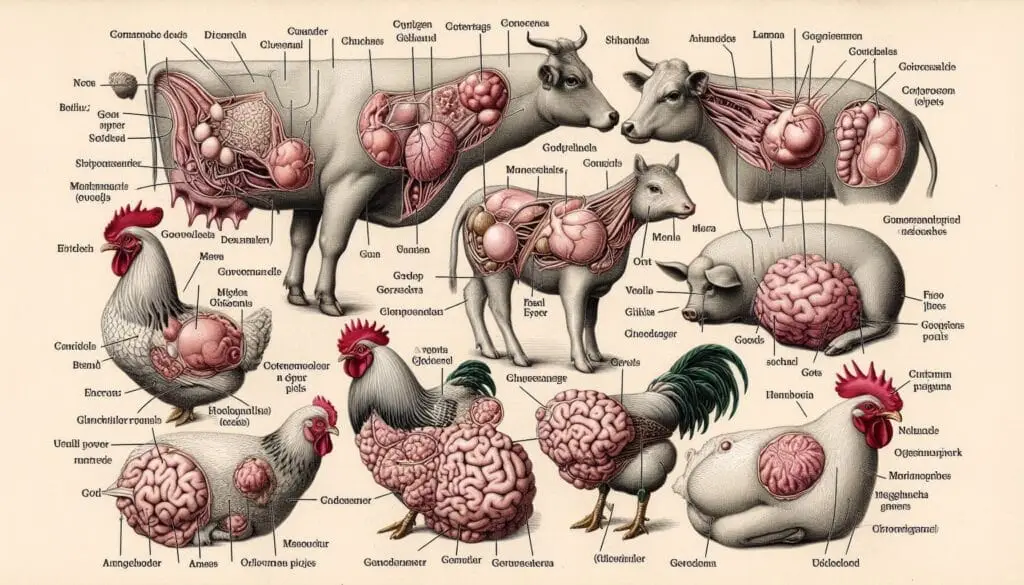Animal Responses to Environmental and Physiological Stimuli

Introduction
Animals constantly interact with their environments. They respond to various stimuli that can be classified as either environmental or physiological. Understanding these responses is crucial for comprehending animal behavior and survival strategies. This article delves into the types of stimuli animals encounter, their responses, and the underlying mechanisms that drive these behaviors.
What Are Environmental Stimuli?
Environmental stimuli are changes in an animal’s surroundings that provoke a reaction. These stimuli can be physical, chemical, or social in nature.
Types of Environmental Stimuli
Physical Cues
- Temperature changes can signal seasonal shifts. For instance, many animals prepare for winter by seeking shelter or storing food.
- Light variations influence behaviors such as migration and reproduction. Birds often migrate based on daylight changes.
Chemical Signals
- Pheromones are chemical signals used for communication among species. For example, ants release pheromones to mark trails to food sources (source).
- The presence of certain chemicals can indicate food availability or danger.
Social Interactions
- Animals often respond to the behaviors of others in their species. For example, a group of gazelles may flee when one detects a predator.
Behavioral Responses to Environmental Stimuli
Animals exhibit various behavioral responses to environmental stimuli:
- Flight Responses: When threatened, many animals will flee to safety. This instinctive reaction is crucial for survival.
- Foraging Behavior: Animals search for food based on environmental cues like the scent of ripe fruit or the presence of other foragers.
- Mating Displays: Many species perform specific behaviors to attract mates, often triggered by environmental factors such as seasonal changes.
What Are Physiological Stimuli?
Physiological stimuli refer to internal cues that affect an animal’s behavior and physical state. These cues often arise from the body’s needs or conditions.
Types of Physiological Stimuli
Hormonal Changes
- Hormones play a significant role in regulating behavior. For example, increased testosterone levels can lead to more aggressive behavior during mating seasons.
Internal States
- Hunger and thirst are powerful motivators for behavior. An animal that is hungry will actively seek food sources.
Stress Responses
- Stressful situations trigger physiological changes such as increased heart rate and adrenaline release. These changes prepare an animal for fight-or-flight responses.
Physiological Responses to Internal Stimuli
Animals respond physiologically to internal stimuli in several ways:
- Metabolic Adjustments: When food is scarce, some animals lower their metabolic rates to conserve energy.
- Behavioral Changes: An animal may become more aggressive when hungry or more lethargic when stressed.
- Reproductive Cycles: Hormonal fluctuations influence mating behaviors and cycles in many species.
For further insights into physiological responses in animals, check out this article on animal physiology.
The Interplay Between Environmental and Physiological Stimuli
The interaction between environmental and physiological stimuli is critical for an animal’s survival. These two types of stimuli often work together to shape behavior.
Cognitive Appraisal of Stimuli
Recent studies suggest that animals evaluate stimuli based on their potential impact on survival. This cognitive appraisal influences how they respond:
- Predictable vs. Unpredictable Stimuli: Animals often react differently based on whether they perceive a stimulus as predictable or not.
- Emotion-like States: Some researchers argue that animals experience emotions that affect their responses to stimuli. For instance, fear can lead to avoidance behaviors while curiosity may encourage exploration.
To explore cognitive appraisal further, visit this resource on animal cognition.
Examples of Responses to Combined Stimuli
Alarm Responses
- When faced with danger, many animals exhibit freezing behavior before deciding whether to flee or fight.
Exploratory Behavior
- In unfamiliar environments, animals engage in exploration to gather information about potential threats or resources.
Social Behaviors
- Social species often adjust their behaviors based on group dynamics influenced by both environmental cues and physiological states.
Case Studies of Animal Responses
To better understand how these concepts apply in real-world scenarios, let’s look at some case studies:
Case Study 1: The Arctic Fox
The Arctic fox (Vulpes lagopus) adapts its behavior based on both environmental and physiological factors:
- In winter, it grows a thick coat that insulates against cold temperatures (environmental).
- During breeding season, hormonal changes prompt increased territorial behavior (physiological).
You can read more about Arctic fox adaptations here.
Case Study 2: Honeybees
Honeybees (Apis mellifera) provide another excellent example:
- They communicate through pheromones when they find food sources (chemical signals).
- Their foraging behavior adjusts based on the availability of nectar and pollen (physiological need).
For more information on honeybee communication and behavior, check out this article from ScienceDirect.
The Role of Learning in Response to Stimuli
Learning plays a vital role in how animals respond to both environmental and physiological stimuli. Through experience, animals adapt their behaviors over time.
Types of Learning
Classical Conditioning
- Animals learn associations between stimuli through experiences. For example, dogs learn to associate the sound of a bell with mealtime.
Operant Conditioning
- This involves learning through consequences. Animals may repeat behaviors that result in positive outcomes (like receiving food).
Social Learning
- Many species learn by observing others. Young wolves learn hunting techniques by watching older pack members.
To dive deeper into learning mechanisms in animals, refer to this guide on animal learning.
Impact of Learning on Survival
Learning allows animals to adapt their responses based on past experiences:
- Animals that learn quickly can avoid dangers more effectively.
- Those that adapt their foraging strategies based on previous successes are more likely to thrive.
Conclusion
Understanding how animals respond to environmental and physiological stimuli provides valuable insights into their behavior and adaptation strategies. By exploring both types of stimuli—environmental cues like temperature changes and physiological needs like hunger—we gain a clearer picture of how animals navigate their worlds.
This knowledge not only enhances our understanding of animal behavior but also informs conservation efforts and animal welfare practices.
More from Veterinary Physiology:
https://wiseias.com/abo-blood-group-system-animals/
https://wiseias.com/anticoagulation-in-animals/
https://wiseias.com/hemorrhagic-disorders-in-animals/






Responses